Click a picture to display the recipe — click the text
in the center for a discussion about asparagus.
HOME
©2000, 2014 Peter Hertzmann. All rights reserved.
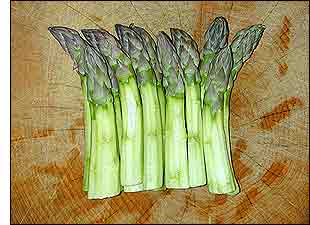 I like asparagus — I like it a lot! My favorite are the big, fat, white asparagus that I’ve eaten in Southern Germany and Switzerland during spargel season in early May. In Northern California, where I live, green asparagus are the common variety and the season starts earlier. At its peak, when the quality is best and the price is lowest I’ll eat asparagus at almost every dinner.
I like asparagus — I like it a lot! My favorite are the big, fat, white asparagus that I’ve eaten in Southern Germany and Switzerland during spargel season in early May. In Northern California, where I live, green asparagus are the common variety and the season starts earlier. At its peak, when the quality is best and the price is lowest I’ll eat asparagus at almost every dinner.
When I can get fat spears, those close to an inch in diameter, I prefer to eat them lightly sauced. Since they are usually trimmed sufficiently, I only cut a quarter inch of dried stalk from the base and lightly peel the remaining stalk with a vegetable peeler. At other times when I’m “forced” to buy the narrower variety, I use the asparagus spears, unpeeled, in soup. This size also works well for Chinese- and Japanese-style dishes. I used to snap off the end as recommended in many books, but I’ve found that too much usable asparagus is discarded. Now I just cut off the tough portions.
Technically speaking, asparagus, a genus of Liliaceae (the lily family including leeks and onions),1 contains more than 100 species found in the warm and temperate regions of America and Europe.2 Both the Greeks and Romans are known to have eaten asparagus. The Egyptians even shared them with their gods.3 It is thought that the Arabs introduced asparagus into Spain and from there it spread to France. Early colonists to North America were known to have planted asparagus.
Until modern times, asparagus has been a food for the rich. In 1843, asparagus and beef were priced similarly at about a half franc per pound. In former times, one to one-and-a-half pounds of asparagus were allotted per diner. Nowadays, three-eighths to a half pound per person is more common. Maybe it was asparagus’ reputation as an aphrodisiac that caused larger portions to be served in the past. Additionally, Platina in 1475 noted its diuretic qualities.4
I guess some people may think of it as a fun food as well, since it’s one of the few cooked vegetables that one can eat with fingers in polite society.5 I think the best reason to eat asparagus is that it tastes good.
- Harold McGee, On Food and Cooking, Charles Scribner’s Sons, New York, 1984, p 194.
- Prosper Montagné, Larousse Gastronomic. Crown Publishers, New York, 1961. pp 61-3.
- Maguelonne Toussaint-Samat, A History of Food, Blackwell Publishers, Cambridge MA, 1993, pp 701-6.
- T. Sarah Peterson, Acquired Taste, Cornell University Press, Ithaca NY, 1994, p 52, 113-5. Also contains many old recipes for asparagus preparation, pp 123-7, 129.
- Craig Claiborne, Elements of Etiquette, William Morrow and Company, New York, 1992, p 110.
CLOSE
©2000, 2014 Peter Hertzmann. All rights reserved.
This asparagus soup recipe was adapted from a more elaborate one published on the web as a sample from Daniel Boulud’s cookbook: Cooking with Daniel Boulud. His original recipe included a sweet red pepper coulis. In my opinion, the coulis detracted from the flavor of the basic soup. Hence this retroversion that’s more like a traditional creamy asparagus soup. A small amount of potato is used to thicken the leek-asparagus purée.
This is a soup that can be served warm early in the asparagus season and cold at the end of the season when the weather is warmer. These are also the times when the quality of asparagus available may be less than desirable for serving whole.
velouté aux asperges
1/2 cup
leeks, white part only, split, thickly sliced
2 tablespoons
potato, 1/8 inch dice
3/4 pound
asparagus, cleaned, 1/2 inch slices
1 sprig
Italian parsley, leaves only
- Heat olive oil in a sauce pan over medium heat. Add leeks and sweat for about 5 minutes — do not brown.
- Add stock and potato. Bring to a boil and cook for about 6 minutes. Add asparagus and parsley, reduce to simmer, cover, and cook for an additional 5 minutes or so until asparagus is tender.
- Transfer soup to a blender and purée. Place in an ice bath and cool. Strain cooled soup through a strainer.
- Test for salt. Refrigerate until ready to serve.
- [Optional] Serve with a small dollop of crème fraîche.
Note: May be served cold or gently reheated.
Yield: 2 servings.
Source: adapted from Daniel Boulud at http:/www.danielnyc.com/cookbooks/asparagus.html, May 1999.
CLOSE
©2000, 2014 Peter Hertzmann. All rights reserved.
The trick to perfecting this recipe is to have just enough water to cook the asparagus spears sufficiently before it all evaporates. If there is too much water, the asparagus can be overcooked before the sauce is reduced sufficiently. The asparagus may not be tender enough. When cooked, serve the asparagus immediately.
The original recipe called for serving the asparagus on a piece of brioche toast, but I like them plain and served as a first course.
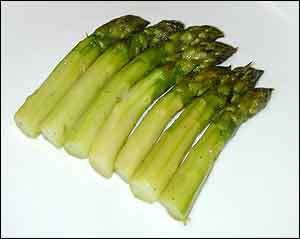
asperges au beurre
3/4 to 1 pound
fat asparagus spears, trimmed and peeled
salt and freshly ground pepper to taste
- Place asparagus spears in a sauté pan large enough to hold them in a single layer. Add water to come to about half way up the asparagus. Add butter, salt, and pepper.
- Place pan over high and cook until water is boiled away and asparagus are cooked. Serve immediately.
Yield: 2 servings.
Source: adapted from Michael Roberts, Parisian Home Cooking, 1999, page 98.
CLOSE
©2000, 2014 Peter Hertzmann. All rights reserved.
For absolute asparagus taste, this recipe is a winner. The basic soup is asparagus purée, chicken stock, and salt — nothing else. The garnish is a nice addition, but not necessary.
soupe aux pointes d’asperges
1 pound
green asparagus, peeled
400 milliliters
chicken stock
3 sprigs
chervil, leaves only
- Trim the tips of the asparagus to 4 cm. Cut the remainder of each stalk into 3 or 4 pieces each. Blanch tips in boiling, salted water for 3 minutes, longer if very thick, and cool in ice water. Drain well and set aside.
- Cook stalks in boiling, salted water for about 7 minutes until tender. Drain and transfer to a food processor. Purée well. Strain to remove any strings that remain. Combine with chicken stock and salt to taste.
- Just before serving, bring soup to serving temperature. In a small, non-teflon coated sauté pan, melt butter over high heat. Brown asparagus tips.
- Arrange tips in individual, heated soup bowls. Divide soup among the bowls. Garnish with chervil leaves.
Yield: 2 servings.
Source: Bernard Loiseau, Cuisine en Famille, 1997, page 34.
CLOSE
©2000, 2014 Peter Hertzmann. All rights reserved.
The original recipe for this dish called for half white and half green asparagus. Unfortunately, good quality white asparagus are rarely available in this area. If you want to prepare the dish ahead of time, chill the asparagus in ice water immediately after cooking to preserve their texture and color. Then drain them well and set aside until serving.
At first glance, the sauce appears to be an ordinary thousand island dressing, but the crème fraîche and cognac give it a different character than one may expect.
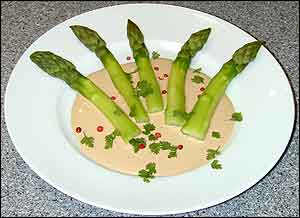
asperges sauce aurore
10 (about 3/4 pound)
fat, green asparagus spears
1 tablespoon
chervil leaves
2 tablespoons
orange juice
1 tablespoon
crème fraîche
1/2 teaspoon
Worcestershire sauce
salt and freshly ground pepper to taste
- Cook asparagus in boiling, salted water until barely tender. Drain on paper towels.
- While the asparagus are cooking, whisk the mayonnaise in a mixing bowl until loose. Add remaining sauce ingredients and mix thoroughly. Set aside.
- Divide the sauce among the servings plates. Arrange asparagus spears on the sauce. Sprinkle a few pink peppercorns on the asparagus. Sprinkle chervil leaves over spears.
Yield: 2 servings.
Source: Cuisine Actuelle, May 1999, page 52.
CLOSE
©2000, 2014 Peter Hertzmann. All rights reserved.
This is a nice dish for brunch or picnics. The pastry can be prepared the day before and rolled out for baking the morning of preparation. Gruyère can be substituted for the parmesan cheese.
quiche aux asperges vertes et au parmesan
11/2 cups
all-purpose flour
1/2 cup
cold sweet butter, cut into small pieces
3 to 4 tablespoons
cold water
500 grams
green asparagus, trimmed, peeled, and cut into 3-inch pieces
200 milliliters
heavy cream
3 tablespoons
chives cut into 1/4 inch pieces
1/4 teaspoon
ground nutmeg
1/8 teaspoon
cayenne pepper
salt and black pepper to taste
100 grams
freshly grated Parmesano-Regianno cheese
- For pâte brisée: combine flour, salt, and butter in the bowl of a food processor. Process for 10 to 12 seconds until the mixture is dry and crumbly. Add water and pulse 12 to 14 times until the dough begins to hold together, but before it turns into a ball. Remove dough from processor bowl and shape into a smooth disk. Wrap with plastic wrap and refrigerate for at least an hour. (The dough may be stored in the refrigerator for 2 to 3 days.)
- Bring dough to room temperature. Butter a 12-inch tart pan. Roll the dough on a floured work surface until it is 1/8 inch thick and 15 inches in diameter. Transfer the dough to the pan and gently press it into the bottom and fluted sides of the pan. Fold the edges over to create a 1/4 inch border above the rim. Flute the edges and prick the bottom of the pan with a fork. Refrigerate for at least 15 minutes.
- For filling: cook asparagus in boiling, salted water until barely cooked. Drain and chill in an ice water bath. Drain on paper towels and set aside.
- Preheat the oven to 410 °F.
- Combine the cream, eggs, chives, nutmeg, cayenne, salt, and pepper in a bowl.
- Sprinkle half the cheese evenly over the bottom of the tart shell. Arrange the asparagus in a single layer over the cheese. Carefully and evenly pour the filling mixture over the asparagus. Sprinkle the remaining cheese over the filling.
- Bake for 35 minutes. Serve warm.
Yield: 6 servings.
Source for pâte brisée: Linda Dannenberg, French Tarts, 1997, page 16; for filling: Guide Cuisine, April 1998, page 18.
CLOSE
©2000, 2014 Peter Hertzmann. All rights reserved.
This is not the dish to eat just before having a cholesterol test, but at other times it’s quite tasty! My preference is to use vary fat asparagus, but thinner ones will do as well.
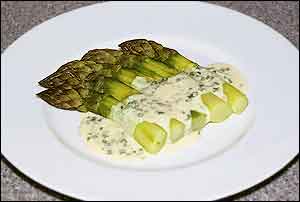
asperges au beurre de ciboulette
3/4 to 1 pound
asparagus, trimmed and peeled
1/4 cup
chilled butter, diced
2 tablespoons
minced fresh chives
salt and freshly ground white pepper to taste
- Place cream in a small sauce pan over medium heat. Reduce substantially.
- Cook asparagus in salted boiling water until tender. Drain well and arrange on heated serving plates.
- Add butter to cream and beat until butter is incorporated. Add chives, adjust seasoning, and sauce the plated asparagus. Serve immediately.
Yield: 2 servings.
Source: Guide Cuisine, April 1998, page 26.
CLOSE
©2000, 2014 Peter Hertzmann. All rights reserved.
Because the warm asparagus are mixed with the dressing and allowed to sit for 30 minutes, the asparagus will lose some of its bright green color. I use a loaf pan for the marinating so the asparagus stays parallel during mixing and has good contact with the dressing. For appearance sake, trim the asparagus the same length as the pan.
asperges vinaigrette
10 to 12 (3/4 to 1 pound)
fat, fresh asparagus spears, peeled
1 tablespoon
red wine vinegar
4 tablespoons
extra virgin olive oil
1 teaspoon
finely minced, fresh thyme
1 teaspoon
finely minced, fresh oregano
1 teaspoon
finely minced, fresh rosemary
1/2 tablespoon
minced, fresh chives
- Whisk together mustard and vinegar. While continuing to whisk, add olive oil in small amounts until an emulsion is formed. Add herbs and mix. Set aside.
- Bring a large sauce pan of salted water to a full boil. Cook asparagus spears until barely cooked and still bright green. Drain well and mix with dressing.
- Set aside for 30 minutes, mixing occasionally.
Note: use a loaf pan for mixing asparagus with dressing. Trim asparagus to length to fit pan.
Yield: 2 servings.
CLOSE
©2000, 2014 Peter Hertzmann. All rights reserved.
The original recipe used 150 grams (about 1/3 pound) of fresh morel mushrooms. The mushrooms were removed from the sauce after about 15 minutes of cooking and added back at the end. It’s rare that I can find fresh morels in my local market so I’ve substituted the dried variety. There are less dried mushrooms used in proportion to the asparagus than the fresh because the higher proportion turned out to be a bit too rich.
On one occasion, I forgot to sprinkle the parmesan cheese over the top at the end of cooking — that's when this picture was taken — and the consensus of the guests was that it was not needed. I still think it is a nice addition.
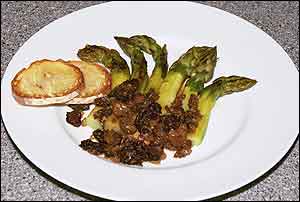
asperges vertes rôties aux morilles
1 large
shallot, finely minced
16 grams
dried morel mushrooms, soaked, cut into 1/2 inch pieces
1 large
clove garlic, minced
salt and freshly ground pepper to taste
3/4 pound (12 to 16)
fat asparagus tips, trimmed and peeled
15 grams
freshly grated Parmesano-Regianno cheese
- In a sauce pan, melt 1 tablespoon butter. Sweat shallots over medium heat. Add mushrooms and garlic. Mix well. Add stock and turn heat to high. Reduce until almost dry. Salt and pepper to taste. Set aside.
- Blanch asparagus in salted water for about 6 minutes until cooked but not tender. Cool in ice water and drain on paper towels. Set aside.
- In a sauté pan large enough to cook the asparagus in a single layer, melt 1 tablespoon butter over high heat. Add asparagus, lower heat to medium, and cook until asparagus is heated through and starts to brown. Be careful not to break any of the asparagus tips.
- Re-heat the mushroom sauce.
- Arrange asparagus on serving plates. Divide sauce among plates. Sprinkle cheese on top and serve immediately.
Yield: 2 servings.
Source: adapted from Françoise Bernard and Alain Ducasse, La Bonne Cuisine, 1999, page 169.
CLOSE
©2000, 2014 Peter Hertzmann. All rights reserved.
In Guy Savoy's original recipe he made a fresh mayonnaise using grapeseed oil. Enough dressing was prepared from one egg yolk to sauce 3 pounds of asparagus. Since I prepare most of my dishes for only two people, I decided to use a good quality prepared mayonnaise. The dressing can be prepared ahead of time, but cook the asparagus just before serving.
asperges tièdes au paprika
3/4 pound
fresh asparagus, peeled and trimmed
1 teaspoon
red wine vinegar
1 teaspoon
sherry vinegar
1 teaspoon
paprika powder
- Whip the mayonnaise with a whisk. Add the remaining ingredients and whisk to combine. Set dressing aside in refrigerator until needed.
- Cook the asparagus in boiling, salted water. When done, drain well and divide among serving plates.
- Spoon dressing over each group of asparagus.
Yield: 2 servings.
Source: “Guy Savoy Encyclopédie Culininaire” at http:/www.guysavoy.com/recette/asperge1.html, April 1999.
CLOSE
©2000, 2014 Peter Hertzmann. All rights reserved.
It’s very important in this dish not to overcook the chicken. I remove it from the poaching liquid when it's still rare and let it finish “cooking” while it relaxes. The chicken should be sweet and not the least bit dry.
All the tastes in this dish are subtle — it’s best to serve it without further accompaniment. (Other than a nice, light white wine, of course!)
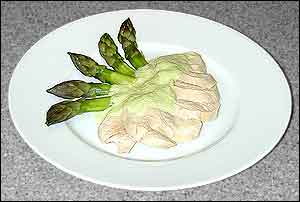
blancs de volaille aux asperges
10 (about 1 pound)
fat, green asparagus spears
200 milliliters
chicken stock
200 milliliters
heavy cream
1
chicken breast, boneless, trimmed into 2 halves
- Trim the tails from the asparagus spears yielding 10 tips of the same length and about 200 grams of stems. Peel the tips and set aside.
- In a small sauce pan, bring some water to a boil and cook the stalks until well cooked, but still green. Drain. Purée stems in a food processor. Strain purée through a fine strainer. Set aside. There should be about 100 milliliters of asparagus purée.
- Place the chicken stock (200 milliliters) in a small sauce pan and reduce substantially. Add cream and reduce further. Set aside.
- Place the remaining chicken stock in a shallow pan large enough to hold the chicken breasts in a single layer. Bring to a boil. Add breasts and reduce to a simmer. Poach until almost cooked, about 7 minutes. Drain, set aside, and tent with foil for 5 minutes.
- Meanwhile, bring some salted water to a boil in a sauce pan. Cook asparagus tips until tender, but still bright green. Drain well on paper towels. Start cooking the asparagus tips just when the chicken is removed from its poaching liquid.
- Reheat the sauce and add the asparagus purée. Salt to taste.
- Slice the breasts crosswise and fan out on serving plates. Arrange asparagus tips on plates and top with sauce.
Yield: 2 servings.
Source: “Guy Savoy Encyclopédie Culininaire” at http:/www.guysavoy.com/recette/asperge2.html, April 1999.
CLOSE
©2000, 2014 Peter Hertzmann. All rights reserved.
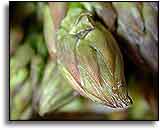
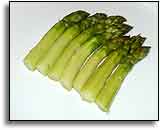
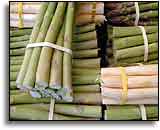
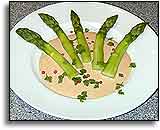
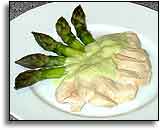

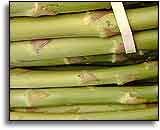
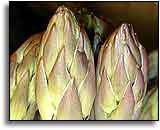
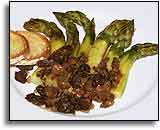
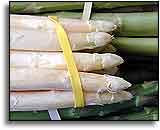
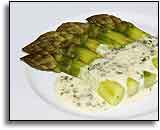











 I like asparagus — I like it a lot! My favorite are the big, fat, white asparagus that I’ve eaten in Southern Germany and Switzerland during spargel season in early May. In Northern California, where I live, green asparagus are the common variety and the season starts earlier. At its peak, when the quality is best and the price is lowest I’ll eat asparagus at almost every dinner.
I like asparagus — I like it a lot! My favorite are the big, fat, white asparagus that I’ve eaten in Southern Germany and Switzerland during spargel season in early May. In Northern California, where I live, green asparagus are the common variety and the season starts earlier. At its peak, when the quality is best and the price is lowest I’ll eat asparagus at almost every dinner.



